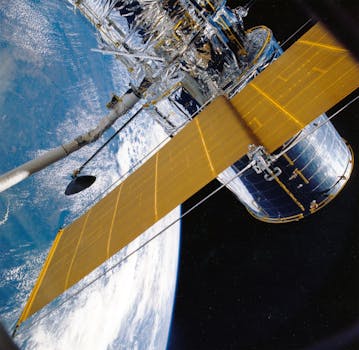GEO Satellites: Unlocking the Power of Geostationary Orbit

GEO Satellites: Unlocking the Power of Geostationary Orbit
GEO satellites, or geostationary satellites, are a type of satellite that orbits the Earth at an altitude of approximately 36,000 kilometers, remaining stationary relative to a fixed point on the planet. This unique characteristic allows GEO satellites to provide continuous coverage of a specific region, making them an essential component of modern satellite communications. GEO satellites have been in use for decades, with the first GEO satellite, Syncom 2, launched in 1963. Since then, the technology has evolved significantly, with advancements in materials, propulsion systems, and payload capacity.
GEO satellites operate in the geostationary orbit, which is a circular orbit that lies in the equatorial plane of the Earth. This orbit is special because it allows the satellite to maintain a fixed position relative to the Earth’s surface, ensuring continuous coverage of a specific region. The geostationary orbit is approximately 36,000 kilometers above the equator, and it takes the satellite 24 hours to complete one orbit. This synchronization with the Earth’s rotation enables GEO satellites to provide real-time services, such as television broadcasting, telecommunications, and weather forecasting.
Applications of GEO Satellites
GEO satellites have a wide range of applications, including television broadcasting, telecommunications, weather forecasting, and navigation. They are also used for military communications, Earth observation, and scientific research. One of the most significant benefits of GEO satellites is their ability to provide global coverage, enabling communication services to reach remote and underserved areas. Additionally, GEO satellites can be used to provide backup services during natural disasters or outages, ensuring continuity of critical communications.
The use of GEO satellites in television broadcasting has revolutionized the way we consume media. With the ability to transmit signals to a wide audience, GEO satellites have enabled global broadcasting, allowing people to access a vast array of channels and programs. Furthermore, GEO satellites have played a crucial role in the development of telecommunications, providing internet connectivity and voice services to remote and underserved areas.
Technological Advancements
Recent technological advancements have significantly improved the capabilities of GEO satellites. The development of high-throughput satellites (HTS) has enabled the provision of faster and more reliable internet services. HTS satellites use multiple spot beams to provide higher bandwidth and faster data transfer rates, making them ideal for applications such as broadband internet and cellular backhaul. Additionally, the use of advanced materials and propulsion systems has increased the efficiency and lifespan of GEO satellites, reducing the cost of launch and operation.
The introduction of electric propulsion systems has also enhanced the capabilities of GEO satellites. Electric propulsion systems use electrical energy to accelerate ions or xenon gas, providing a high specific impulse and increasing the satellite’s maneuverability. This technology has enabled GEO satellites to maintain their position and altitude more accurately, reducing the need for costly and complex station-keeping maneuvers.
Future of GEO Satellites
The future of GEO satellites looks promising, with ongoing developments in technology and applications. The increasing demand for satellite-based services, such as broadband internet and telecommunications, is driving the growth of the GEO satellite market. Additionally, the development of new technologies, such as reusable launch vehicles and advanced propulsion systems, is expected to reduce the cost of launch and operation, making GEO satellites more accessible and affordable.
The use of GEO satellites in emerging applications, such as the Internet of Things (IoT) and 5G networks, is also expected to drive growth. The IoT requires a network of interconnected devices, and GEO satellites can provide the necessary connectivity and coverage. Furthermore, the development of 5G networks will rely heavily on satellite-based services, with GEO satellites providing the necessary backhaul and connectivity.



